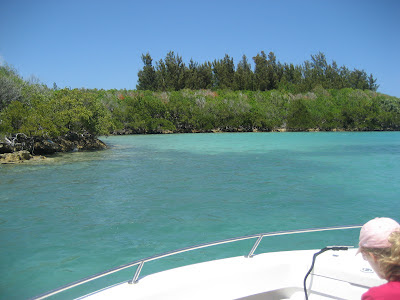Suffering for my Art
On my last day of digging at Smiths Island (also alone, on the 10th), I was bound and determined to finally get to the eastern tip of the island to verify that the 1970s hydroponic farming did indeed level the area where there's now a stand of casuarina trees. The late historian Jack Arnell had speculated that Richard Moore, Bermuda's first governor (1612-15) might have built a battery there as a more handy alternative to Smiths Fort on Governor's Island. In reconnoitering the island for sites in 2010 we never got east of Smallpox Bay due to the thicket of intertwined Mexican pepper trees and poison ivy. But today I decided I'd DO IT!
 |
| The elusive casuarinas of Smiths Island's East End, beckoning like a siren... |
Big Mistake, but I had hubris apenty that morning. The first hurdle was getting even as far as we could in 2010 - the field past the CHB site are now more matted with poison ivy than before, as well as a plethora of short stubby brush. I pushed on through this until I refound a spot we located in 2010 where there was a huge pile of black plastic tarp and seedling containers. With this landmark I advanced - only to nearly walk into a wild hive aswarm with bees!
I cleared out sharpish but now couldn't return the way I came. I stumbled upon the faint trace of the main road from the 1980s, but the Mexican Pepper trees on both sides had sent out sideways shoots across it, forcing me alternately to crawl in the 2-foot space beneath the interlocking canopy or, when poison ivy carpeted this space, to judiciously use pruning shears, battling for every foot. Half an hour got me maybe 100 yards closer as the heat of the day built. I should have turned back then, but those casuarinas seemed so close each time I looked. When the road ended, it just became a matter of threading through the allspice stands as a better alternative to the Evil that is Mexican Pepper when I could. Finally, I saw this:
Not much to look at, but the verge of victory for me! By now I was thoroughly scratched up, hot and sweaty, and now itching from poison ivy. The casuarinas were actually not on a flat bulldozed area (as the aerial photos of the 1970s suggested) but on a hill with quite shallow soil. No evidence of a fort, but it would seem the stratigraphy is probably intact. I did find some evidence of quite recent farming - probably 5 to 10 years ago - with a raised bed, water butt, several large pots, and a lounge chair. Hmmm... wonder what they'd be growing at such a remote location?
Much of the rest of the day was spent gathering up and returning all the BNT's equipment (except sifters), returning the work boat to Geoffrey, and moving out of my palatial quarters at Red Barracks (with much regret and reluctance, but the Michaels were due back that evening). I've now moved Up De Contry to Paget, just across the harbour from Hamilton into equally nice quarters! I washed and bagged up all this summer's artifacts yesterday and spent today in coolness of the Bermuda Archives, reading up on a 1754 vice admiralty court case, several slave manumissions, and about maritime quarantine and smallpox laws. The coolest find of today wasn't in the archives at all, but at Devondale - an old farm property in Devonshire just willed to the Bermuda National Trust. In the cellar among a stack of old pictures and frames, I found a remarkably well-preserved signed and dated embroidery sampler:
A quick check of parish records revealed that Julia Dill Tynes was 9 years old when she made this in 1846. After a day of reading official male-centered documents in the archives, this sampler was so intimate and personal and different, driving home the imbalance of Bermudian history - so many more women than men, yet the details of their lives are largely lost. I hoped that the sampler would mark young Julia's transition toward womanhood/adulthood, marriage, and the "charm" of "domestic life" she sought - but it was not to be: she died in 1915, having never wed, probably staying on in others' households as a maiden aunt to help out kinswomen who did marry and have children. Maybe she was happy or at least made her peace with such a life, earning in the end "Heaven's applause", but when she put needle and thread to cloth in 1846 her future was still uncharted. This is why material culture is so important: samplers and sherds, postholes, bottles, and nails, portraits and houses - they flesh out the partial skeleton that is the best that historical documents can give us.





.jpg)
Comments